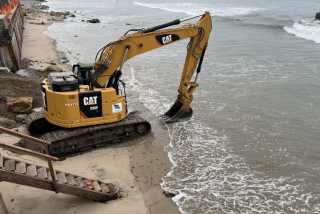Losing a Place in the Sun
- Share via
There are more than 1,400 privately owned spots along California’s dazzling coastline where, theoretically at least, beachgoers can spread their towel or climb down a set of stairs to get to the surf.
The owners of those dirt paths and sand strips agreed years ago to let the public pass in exchange for the state Coastal Commission’s permission to build on or remodel their property. On densely built stretches, like portions of Malibu, those promised easements are the only way that Californians would be able to get to the shore, which state law holds in trust for everyone.
But ensuring they can get there is easier said than done. Many wealthy owners have hired lawyers to block state efforts to open the promised access paths. Homeowners along Malibu’s Broad Beach have proved especially adept, hiring dune-buggy-riding private cops to chase away beachgoers. Even when homeowners stand by their promises, the agency has struggled to expand access.
A new report from the legislative analyst’s office, one in a series of agency reviews, underscores the need for funds that can bring about lasting solutions.
The easements that homeowners have offered typically expire if the state does not “accept” or formally take responsibility for them, often within in 21 years. Forty percent of access ways offered are stuck in this legal limbo. This year, 80 of these dedications will expire, followed by 80 each year for three years after that. Several have already evaporated, meaning that sunbathers and surfers have lost access.
Formalizing these easements involves time-consuming surveys, negotiations and piles of documents. Since the Coastal Commission can’t hold property, a big stumbling block has been finding public or nonprofit agencies willing and able to rebuild a rickety stairway, keep beach paths clean and assume liability in the event of an accident. Yet the commission’s budget is so pinched that just two people handle this gargantuan task for the whole state, down from an all-time high of three staffers. The agency has put a priority on nailing down dedications that are within two years of their expiration date, a policy that makes sense in the short run but ensures a state of perpetual crisis.
The state analyst suggests that improved tracking of outstanding easement offers by the commission would help keep them from expiring. So would a speeded-up timetable for processing these dedications and the Legislature’s designation of another agency, along with the Coastal Conservancy, as a last-resort easement holder. All sensible suggestions, but virtually impossible without a stable source of funding.
Californians created the Coastal Commission in 1976 to protect the state’s prized shoreline. In its nearly 30 years, the agency and its leaders have demonstrated extraordinary ingenuity and commitment to that task. But without permanent and stable funding, the state can’t do what voters asked it to do.


